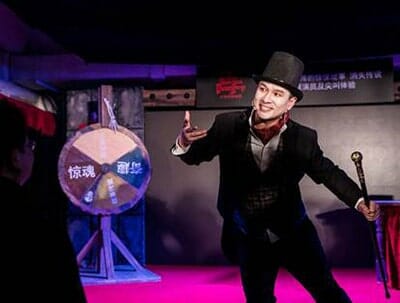
A performer at the ground-breaking of the Shanghai Dungeon at Pradera’s Mosaic Shanghai
Chinese consumers bought RMB 4.88 trillion ($760 billion) in products online during the first three quarters of last year — roughly equivalent to the annual GDP of the Netherlands — as many shoppers now routinely buy groceries and other daily necessities on their phones or computers. As the nation’s 1.4 billion consumers increasingly turn to virtual marketplaces to keep them clothed and fed, shopping centre operators in China are competing to provide unique experiences to give patrons a reason to shop in the real world.
Mosaic Shanghai mall on the city’s East Nanjing Road walking street recently broke ground on the Shanghai Dungeon, a local version of Madame Tussaud’s operator Merlin Entertainment’s popular London Dungeon attraction to help its retail centre pull in more of the crowds mobbing the popular shopping strip.
“The Shanghai Dungeon attraction is set to provide a unique, entertaining and thrilling experience for visitors and tourists from all over Shanghai, China and the world,” said Pradera Asia’s Head of Asset Management Rhys Evans. In the UK, the London Dungeon combines live actors, special effect and cinema-quality sets to take visitors on a fright-filled “tour” of torture chambers and other historical horrors.
The 21st century version of a haunted house will provide the mall an international grade attraction that gives visitors an experience that they can’t get on Taobao.
Young Consumers Look For Experiences to Share

Joy City offers Shanghai shoppers the chance to add a ferris wheel ride to their weekend expedition
Attractions are becoming more important to mall operators, as consumers begin to demand more entertainment options. According to a report published this month by American consulting firm AT Kearney, young consumers prefer experiences over the acquisition of things as they value access to functionality over ownership. The firm predicts that by 2030, young people in the US will allocate only half of their shopping expenditure for products, while the remainder will be used for experiences or experiential products like cameras or sporting goods.
In the future, the strategy-focused consultancy expects that malls will evolve into “large spaces centered around a large attraction.” In its report, AT Kearney said of the evolution of malls, “Instead of a retailer, the anchor here is a compelling social experience — perhaps an indoor ski slope, roller coaster, concert space, or museum providing immersive, experience-based entertainment.”
Fun Times Shove Aside Giant Logos on WeChat
In China, the wealth effect of rising home prices plays a part in the enhanced demand for kids and education facilities, with some experts seeing it as more important than product offerings in pulling consumers into shopping centres.
Theodore Knipfing, Managing Partner of Plus Curiosity, a retail consulting firm based in Hong Kong, said providing unique experiences in malls can be a key element in the retail mix in China. “Shopping may not even be the primary driver or motivation for the modern Chinese consumer to visit the mall. Dining, unique experiences, time with friends or family, cinema, all certainly now come up there in terms of motivations,” said Knipfing in an email. He added that modern Chinese now are more likely be showing off their experience than their branded goods when updating their WeChat moment feeds on social media.
Experiential Retail on the Rise in China

Customers at the Kunming Aegean Sea Shopping Park act on their My Little Pony fantasies
Experiential retail got its first major boost in China when New World Development’s K11 division opened the K11 Art Mall on Shanghai’s Huaihai Road in 2011 — the same year that fellow Hong Kong builder Parkview Group opened its own art-driven Parkview Green in Beijing.
Local mainland developer Dalian Wanda Group took its own experiential gamble soon after by developing a series of malls linked with theme parks, and Joy City, the commercial development arm of state-owned conglomerage COFCO opened a ferris wheel on top of its Shanghai Joy City in early 2016.
Ride a Horse and Fly a Plane at the Mall
Now mall operators are competing to provide more unique attractions. At Kunming Aegean Sea Shopping Park in southwestern China’s Yunnan province, the mall has an equestrian school on its top floor, where patrons can ride, feed and groom the horse of their dreams. A 25-minute horse riding experience costs RMB 198 ($31) on Dianping, a Chinese e-commerce platform.

Hop on a plane, in a Beijing mall
The Beijing Mall on the Chinese capital’s Wangfujing Street takes a more high-tech approach by offering a Boeing 737 Flight Simulator Experience. A 90-minute flight experience simulating take-off, climbing, and landing the passenger plane costs RMB 2800 ($442) per customer.
Knipfing expects more unique experiences to be more available in China’s malls. “Malls won’t really have a choice about this,” he said. “They will need to significantly raise their software game with a lot more diverse, fun, and constantly new content, rather than adding another wing, or getting new wallpaper.”
How does the London Dungeon experience translate into modern Shanghai? Is it medieval European beheadings and quarterings or something more modern? Great Leap Dungeon or Cultural Dungeon perhaps? I can hardly wait, I had always thought shopping on Nanjing East Road was torture enough!
Perhaps you could ask the people at Merlin in London if they hired Peter Humphrey as a consultant in getting all the details right on torture in the Middle Kingdom